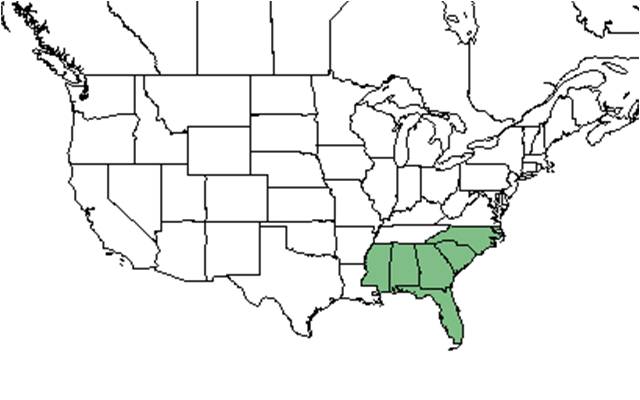Difference between revisions of "Gordonia lasianthus"
KatieMccoy (talk | contribs) (→Description) |
KatieMccoy (talk | contribs) (→Distribution) |
||
| Line 27: | Line 27: | ||
==Distribution== | ==Distribution== | ||
| + | Found in hydric habitats throughout the Coastal Plain. | ||
| + | |||
==Ecology== | ==Ecology== | ||
===Habitat=== <!--Natural communities, human disturbed habitats, topography, hydrology, soils, light, fire regime requirements for removal of competition, etc.--> | ===Habitat=== <!--Natural communities, human disturbed habitats, topography, hydrology, soils, light, fire regime requirements for removal of competition, etc.--> | ||
Revision as of 18:35, 16 December 2015
| Gordonia lasianthus | |
|---|---|

| |
| Photo taken by Gil Nelson | |
| Scientific classification | |
| Kingdom: | Plantae |
| Division: | Magnoliophyta - Flowering plants |
| Class: | Magnoliopsida - Dicotyledons |
| Order: | Theales |
| Family: | Theaceae |
| Genus: | Gordonia |
| Species: | G. lasianthus |
| Binomial name | |
| Gordonia lasianthus (L.) Ellis | |

| |
| Natural range of Gordonia lasianthus from USDA NRCS Plants Database. | |
Common name: loblolly bay
Contents
Taxonomic notes
Description
A description of Gordonia lasianthus is provided in The Flora of North America.
Loblolly bay is a perennial, evergreen tree with large, white, fragrant, cup-shaped flowers. The leaves are leathery, entire, oblong and oblanceolate [1][2]. It often grows with sweet bay, (Magnolia virginiana) and is easily distinguishable by having a light green underside while sweet bay has a white underside [3].
Distribution
Found in hydric habitats throughout the Coastal Plain.
Ecology
Habitat
Gordonia lasianthus has been found along margins of titi swamps, densely wooded hammocks, swampy depressions, cypress domes, an ecotone between a titi-sweet bay swamp and a pond pine flatwood, ravine bottoms, shrub bogs, wet pine flatwoods, mesic steepheads, and bald cypress/mixed hardwoods swamps. It has been found to occur in disturbed areas such as cut-over pinewoods and powerline corridors (FSU Herbarium). It has been observed to grow in loamy sand (FSU Herbarium). Associated species include Stewartia, Illicium, Ilex, Persea borbonia, Magnolia glauca, Rhus vernix, Clethra, Cliftonia, Nyssa, Cyrilla, Pinus elliottii, Quercus nigra, Liquidambar, Magnolia virginiana, Oxydendron, Illicium floridanum, Myrica, Liriodendron, Pickneya, Rhododendron viscosum, Serenoa, Osmunda, Sphagnum, and Lycopodium (FSU Herbarium).
Phenology
Flowers May through July (FSU Herbarium).
Seed dispersal
Seed bank and germination
Fire ecology
Pollination
The following Hymenoptera families and species were observed visiting flowers of Gordonia lasianthus at Archbold Biological Station (Deyrup 2015):
Sphecidae: Ectemnius rufipes ais
Vespidae: Pachodynerus erynnis, Polistes dorsalis hunteri
Use by animals
Diseases and parasites
Conservation and Management
Cultivation and restoration
Photo Gallery
References and notes
Deyrup, M.A. and N.D. 2015. Database of observations of Hymenoptera visitations to flowers of plants on Archbold Biological Station, Florida, USA.
Florida State University Robert K. Godfrey Herbarium database. URL: http://herbarium.bio.fsu.edu. Last accessed: October 2015. Collectors: Loran C. Anderson, Sarah Baxter, James R. Burkhaulter, N.H. Chevalier, Andre F. Clewell, H.S. Conard, H.A. Davis, Wayne R. Faircloth, A. Gholson Jr., R.K. Godfrey, D.W. Hall, Don Harrison, E.A. Hebb, R. Kral, O. Lakela, S.W. Leonard, Hui Lin Li, T. Myint, J.B. Nelson, Jackie Patman, James D. Ray Jr., C. Rhinehart, P.L. Redfearn Jr., Grady W. Reinert, Cecil R. Slaughter, A.G. Shuey, R.R. Smith, E. Tyson, D.B. Ward, Jean W. Wooten. States and Counties: Florida: Alachua, Baker, Bay, Columbia, DeSoto, Dixie, Escambia, Flagler, Franklin, Gadsden, Hamilton, Hardee, Highlands, Hillsborough, Jefferson, Lake, Leon, Liberty, Madison, Manatee, Marion, Nassau, Okaloosa, Orange, Polk, Putnam, Seminole, Taylor, Volusia, Wakulla, Walton.
Georgia: Clarke, Grady. Pennsylvania: Phillidelphia. South Carolina: Pickens. Compiled by Tall Timbers Research Station and Land Conservancy.